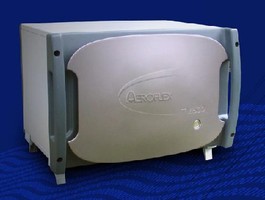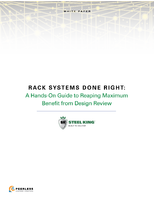Multi-Handset Tester accelerates LTE development projects.
Share:
Press Release Summary:

With up to 32 Long Term Evolution handset UEs, TM500 Multi-Handset Test Mobile simplifies complex tasks such as functional network testing with multiple UEs and performance measurement of resource scheduling algorithms. All 3GPP UE categories are supported with maximum aggregate data rates up to 75 Mbps on uplink and 300 Mbps on downlink. In addition to functional and performance testing, TM500 Multi-UE Test Mobile can be upgraded to support hundreds of UEs for load and stress testing.
Original Press Release:
Aeroflex Accelerates LTE Infrastructure Development with Launch of TM500 LTE Multi-Handset Test Mobile
Aeroflex Secures Contract to Supply New TM500 LTE Multi-Handset Test Mobile for Major Infrastructure Equipment Vendor
Wichita, KS-October 13, 2008-Aeroflex today announced the launch of an LTE version of its industry-standard TM500 multi-handset (multi-UE) test mobile designed to enable infrastructure equipment vendors accelerate the pace of their LTE development projects. At the same time, Aeroflex also announced that it has won a contract to supply a major infrastructure equipment vendor with the TM500 LTE Multi-UE test mobile.
Up to 32 LTE handset UEs are provided in one multi-UE test mobile, which simplifies complex tasks such as functional network testing with multiple UEs and performance measurement of resource scheduling algorithms. An LTE cell can be loaded with multiple UEs using a repeatable time profile in a controlled test environment. All 3GPP UE categories will be supported with maximum aggregate data rates of up to 75 Mbps on the uplink and 300 Mbps on the downlink.
After network infrastructure functional testing has been completed with a single handset (UE), the next step is to test with a second UE, then a third and so on. More often than not, multiple UEs do not function as expected against the network, compared to a single UE. System diagnosis is complicated when independent UEs are used, as each UE attempts to interact with the network separately. A tool such as the TM500 LTE Multi-UE is required, because it can repeatedly generate a test scenario involving a user-defined number of UEs.
The TM500 LTE Multi-UE provides the ability to operate multiple UEs on the same test platform using a single point of control. In addition to functional multi-UE testing, the use of the same test platform enables specific tests that require UE co-ordination for which it is not feasible to use independent handsets. Such tests include contention between UEs attempting to access the network together and the ability to check a network's response if multiple UEs behave unexpectedly or abnormally together. However, each UE still provides 3GPP LTE functionality with its own independent software stack to ensure that it is representative of an LTE handset.
Handset configuration and measurement capabilities are also included to provide infrastructure engineers with the low-level UE access and internal UE visibility they require to properly test and debug the eNode-B (LTE basestation) and network. The performance measurement capabilities of the TM500 LTE Multi-UE can be used to measure, optimize and demonstrate functionality such as the resource scheduler performance of the eNode B.
In addition to its use for functional and performance testing, TM500 Multi-UE Test Mobile can also be upgraded to support hundreds of UEs for load and stress testing in conjunction with third-party capacity test products.
"The multi-UE test capability now being offered on the TM500 LTE will fundamentally help infrastructure equipment vendors accelerate their LTE development by facilitating the engineering transition from one to multiple UE through to performance and capacity testing," said Nick Carter, product manager for the Aeroflex TM500 LTE Multi-UE.
About LTE
LTE (Long Term Evolution) lies on the 3GPP GSM evolutionary path beyond 3G HSDPA/HSUPA and is designed to provide increased data speeds at a lower cost per data bit compared to 3G. It targets data rates in excess of 100 Mbps over the downlink and 50 Mbps over the uplink when operating in the 20 MHz spectrum allocation, climbing to peak rates of 300 Mbps in the downlink for the highest category UEs. LTE technology will also ensure high performance for speeds up to 120 km/h and mobility support across the cellular network for speeds up to 350 km/h. As well as higher data rates, wide-area coverage is also being targeted. The throughput, efficiency and mobility targets must be met for 5 km cells through to 30 km cells and up to 100 km cells. Reduced latency is also being addressed with a target for data-plane latency less than 5 ms in unloaded conditions with small IP packets.
About Aeroflex Test Solutions, Wireless Division
Aeroflex Wireless offers a full range of protocol, physical layer and parametric test solutions for the cellular communications industry. Its products address infrastructure and mobile handset testing and support all stages of mobile phone and radio access network equipment development and deployment. Applications include R&D, conformance, production, installation and commissioning, field service, and network optimization. Aeroflex's wireless products test all key 2G, 2.5G and 3G wireless technologies including UMTS, cdmaOne, CDMA2000, TD-SCDMA, GSM, GPRS, EDGE, WiMAX and LTE worldwide.
About Aeroflex
Aeroflex Incorporated is a global provider of high technology solutions to the aerospace, defense, cellular and broadband communications markets. The Company's diverse technologies allow it to design, develop, manufacture and market a broad range of test, measurement and microelectronic products. Aeroflex Incorporated was founded in 1937 and today has more than 2,600 employees worldwide. Additional information concerning Aeroflex Incorporated can be found on the company's website: www.aeroflex.com.




